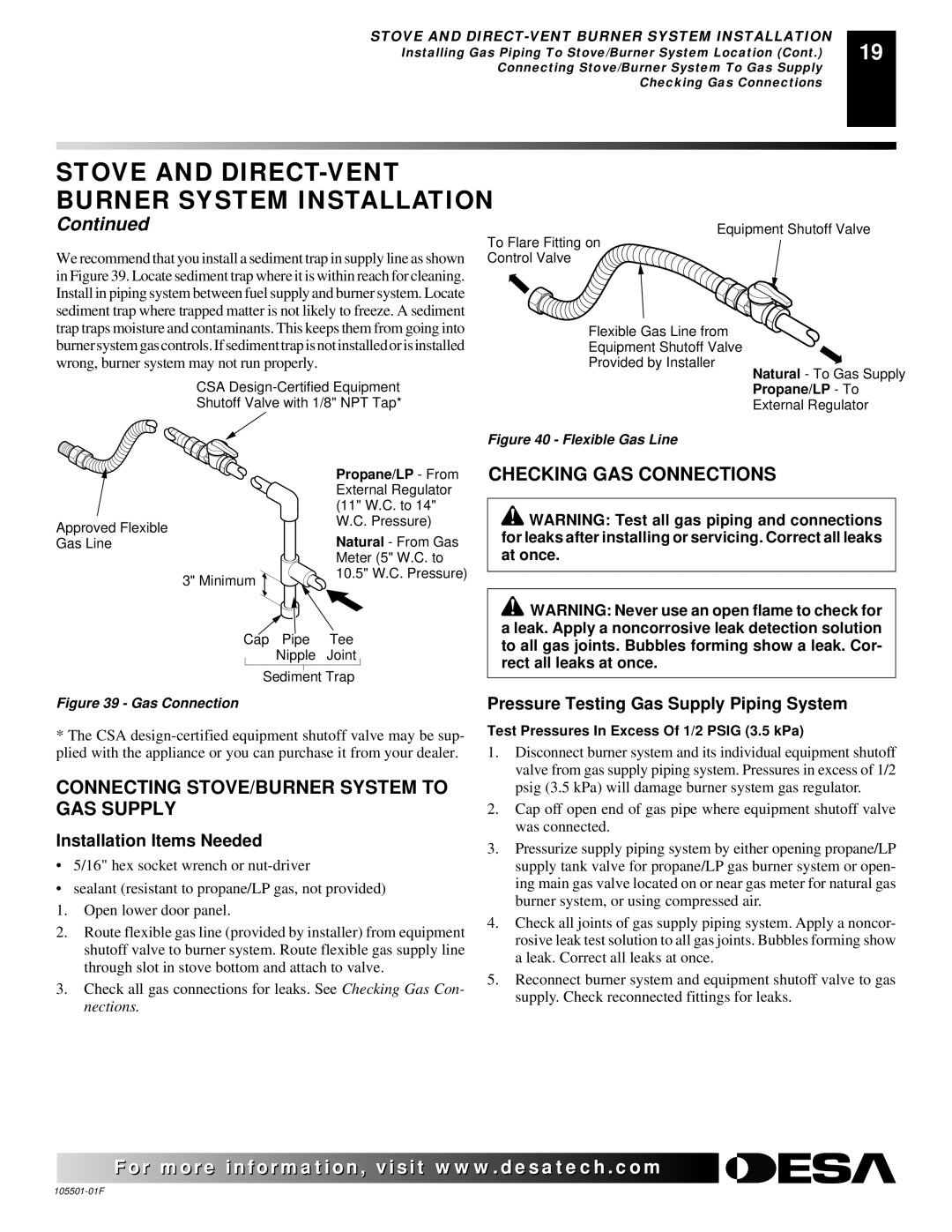
STOVE AND
Installing Gas Piping To Stove/Burner System Location (Cont.) Connecting Stove/Burner System To Gas Supply Checking Gas Connections
19
STOVE AND DIRECT-VENT BURNER SYSTEM INSTALLATION
Continued
We recommend that you install a sediment trap in supply line as shown in Figure 39. Locate sediment trap where it is within reach for cleaning. Install in piping system between fuel supply and burner system. Locate sediment trap where trapped matter is not likely to freeze. A sediment trap traps moisture and contaminants. This keeps them from going into burner system gas controls. If sediment trap is not installed or is installed wrong, burner system may not run properly.
CSA
Shutoff Valve with 1/8" NPT Tap*
Equipment Shutoff Valve
To Flare Fitting on Control Valve
Flexible Gas Line from Equipment Shutoff Valve
Provided by Installer
Natural - To Gas Supply Propane/LP - To External Regulator
Approved Flexible
Gas Line
3" Minimum ![]()
Propane/LP - From External Regulator (11" W.C. to 14"
W.C. Pressure)
Natural - From Gas Meter (5" W.C. to 10.5" W.C. Pressure)
Figure 40 - Flexible Gas Line
CHECKING GAS CONNECTIONS
![]() WARNING: Test all gas piping and connections for leaks after installing or servicing. Correct all leaks at once.
WARNING: Test all gas piping and connections for leaks after installing or servicing. Correct all leaks at once.
![]() WARNING: Never use an open flame to check for a leak. Apply a noncorrosive leak detection solution
WARNING: Never use an open flame to check for a leak. Apply a noncorrosive leak detection solution
Cap Pipe Tee
Nipple Joint
Sediment Trap
Figure 39 - Gas Connection
*The CSA
CONNECTING STOVE/BURNER SYSTEM TO GAS SUPPLY
Installation Items Needed
•5/16" hex socket wrench or
•sealant (resistant to propane/LP gas, not provided)
1.Open lower door panel.
2.Route flexible gas line (provided by installer) from equipment shutoff valve to burner system. Route flexible gas supply line through slot in stove bottom and attach to valve.
3.Check all gas connections for leaks. See Checking Gas Con- nections.
to all gas joints. Bubbles forming show a leak. Cor- rect all leaks at once.
Pressure Testing Gas Supply Piping System
Test Pressures In Excess Of 1/2 PSIG (3.5 kPa)
1.Disconnect burner system and its individual equipment shutoff valve from gas supply piping system. Pressures in excess of 1/2 psig (3.5 kPa) will damage burner system gas regulator.
2.Cap off open end of gas pipe where equipment shutoff valve was connected.
3.Pressurize supply piping system by either opening propane/LP supply tank valve for propane/LP gas burner system or open- ing main gas valve located on or near gas meter for natural gas burner system, or using compressed air.
4.Check all joints of gas supply piping system. Apply a noncor- rosive leak test solution to all gas joints. Bubbles forming show a leak. Correct all leaks at once.
5.Reconnect burner system and equipment shutoff valve to gas supply. Check reconnected fittings for leaks.
![]() For more
For more![]()
![]()
![]() visit www.
visit www.![]()
![]()
![]() .com
.com![]()
![]()
![]()
![]()
![]()
![]()
